Go to Mongolia bird tours | Asian trip reports | All our birding tours
DOWNLOAD TRIP REPORT
By Chris Lotz
12 – 31 JULY 2022
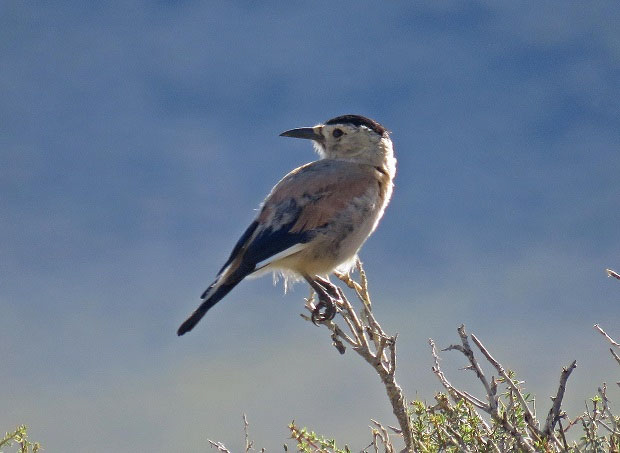
Overview
This was our first mammal-oriented trip to Mongolia, essentially a scouting trip to enable us to set up Snow Leopard and Pallas’s Cat tours in the future. It was a scouting trip outside of the best birding season (May and June) but timed for the leopard. Mongolia has become a great destination for seeing the leopard without freezing as it can be observed in summer at quite mild temperatures high in Mongolia’s beautiful mountains. The vast, sparsely populated landscapes in Mongolia, consisting of deserts, steppes, lakes and mountains, are truly wonderful. We spent the first half of the trip in western Mongolia in the Altai Mountains which is where our main target, Snow Leopard, lurks, but from here we also did birding forays to huge lakes on the vast lower elevation plains and valleys below the mountains (some of these snow-capped). We spent the rest of our time in central Mongolia not far from the capital, Ulaanbaatar.
We managed to find our main target, Snow Leopard, on our second day of searching. We’d allocated a week for it, so after seeing it we then had time for birding the next five days, quite a bit of this in the Great Lakes Depression. We found some excellent bird species although May and June is far better for birding in this country which is when we run our Mongolian birding tours.
Detailed Report
Day 1, 12th July 2022. Arrival in Ulaanbaatar and a full day of birding
We arrived in Ulaanbaatar just after 7 am and transferred to our resort hotel outside the city adjacent to the Tuul River. The hotel grounds proved rewarding for birding, with good numbers of stunningly beautiful Long-tailed Rosefinch, a good number of Azure Tit, several Eurasian Hoopoe, nesting White-cheeked Starling, a flyover Cinereous Vulture, a huge number of Black Kite, and a couple of close-up Amur Falcon. Corvids were plentiful, with Red-billed Chough and Duarian Jackdaw sitting on the hotel building, our first of many Northern Raven, Azure-winged Magpie and an abundance of Eurasian Magpie.
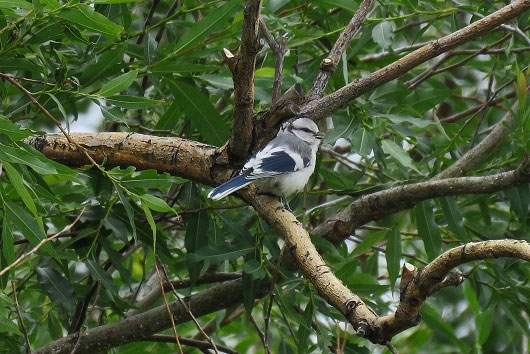
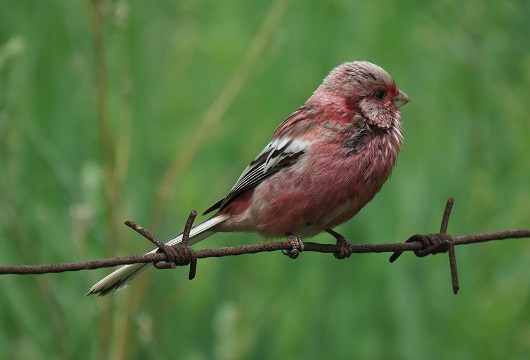
A drive to swan lake was productive with Whooper Swan, a number of duck species, Black-necked Grebe, Great Crested Grebe, Little Ringed Plover and several other shorebirds, etc. A pair of lovely Daurian Redstart were great to see on the way back during a stop along the river.
On the way to Green Lake for some afternoon birding, we enjoyed seeing the Brandt’s subspecies of Horned Lark without any yellow, right next to the road (we’d be seeing stacks of these virtually every day of the tour, though). A mixed flock of Common and Pacific Swifts wheeled above buildings en route as well. At the lake we heard, and briefly saw, Oriental Reed Warbler. Several Richard’s Pipit displayed above our heads and also sang from atop trees. Citrine Wagtail and its more common cousin, White Wagtail, were also present in numbers. A breeding plumage Black-tailed Godwit and a few other waders were enjoyed.
The highlight on the way back to the hotel was a pair of Demoiselle Crane; what an elegantly beautiful bird.
Day 2, 13th July 2022. Further Ulaanbaatar birding and a flight to the Snow Leopard area
We spent another productive morning birding near our hotel (the Mongolica Resort). We were pleased to see close-up Lesser Spotted Woodpecker (a female being followed around by its youngster) in willows along the river. We also enjoyed great views of further Azure Tit, Long-tailed Rosefinch and other desirables. We managed to see our first Upland Buzzard and Cinereous Vulture as we drove to the airport for our domestic flight and the next part of our adventure into the land of the Snow Leopard, the Altai Range (specifically the Jargalant Mountains). We flew to Hovd in western Mongolia and from there drove up to our community-based ger camp. This ger camp would be our base for eight nights looking for Snow Leopard and (time-permitting), birds. Unusually for this arid area, it was raining as we arrived, apparently with snow high in the mountains which would delay our search for Snow Leopard by a day, although what we did instead was nevertheless a real treat.
This was a three Wheatear day, with Pied, Isabelline and Northern. The latter two species were among the most abundant birds on many of the other days (Northern usually more in the mountains and Isabelline on the plains).
Day 3, 14th July 2022. Birding the Great Lakes Depression
We woke up to beautiful weather with clear blue skies. Pallas’s Pika were all over the place (whistling at us and sunning themselves), and Eastern Midday Jird were also around. A flock of Hill Pigeon flew over and in the valley behind the camp were a pair of breeding plumage, “singing” (if you can really call it a song) Barred Warbler and a number of Chukar.
During breakfast, the trackers who were searching for Snow Leopard for us high up in the mountains informed us that the weather was poor with snow cover still on the ground from yesterday, so we opted not to try for the big cats today but instead to travel down into the Great Lakes Depression between the Altai and the Khangai mountains, today. It’s remarkable to see large lakes in the desert (the freshwater Khar – or “black” Lake and the brackish Durgun Lake) with a backdrop of sand dune desert behind the lakes. Today certainly proved to be an amazing adventure with great mammals and birds, descending out of the hills and eventually to Durgan Lake which was teaming with waterbirds.
Both the birds and mammals were excellent today. As we descended, we stopped at a site for the charismatic and attractive Henderson’s (Mongolian) Ground Jay, a family group of which we thoroughly enjoyed spending some time with. Nearby, we saw some displaying Rock Sparrow and a Gobi-Altai Mountain Vole. Isabelline (Daurian) Shrike and Isabelline Wheatear abounded. Raptors were plentiful and included some new ones such as Steppe Eagle and a remarkable number of Saker in a variety of different plumages including the Altai form. A number of Long-legged and Upland Buzzards showed well. Three Little Owl gave us excellent views, one of which was sitting atop a wall.
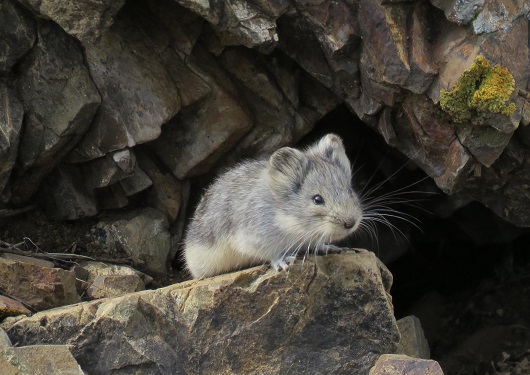
After eventually reaching Durgan Lake, we quickly added many other species to our list as there were plenty of water-associated species. There were many Vega (Mongolian) Gull and a couple of breeding plumage Pallas’s Gull which are like giant Black-headed Gulls (superficially anyway). Black Tern (some of them in full breeding plumage) were plentiful. There was a small number of White-winged Tern (in truly stonking full breeding plumage) among many Common Tern. A number of Little Tern and a handful of Caspian Tern at the opposite end of the size spectrum were also around. A Eurasian Spoonbill (which subsequently proved to be an abundant species at most wetland sites during this tour) and numerous Grey Heron and Great Egret, were in evidence. Hundreds of Greater Sandplover and a smaller number of Kentish Plover accompanied calidrids like Little Stint, Temminck’s Stint and Curlew Sandpiper (most of the latter in breeding plumage) plus a fine Spotted Redshank (also in its black breeding plumage). Black-winged Stilt and Pied Avocet added to the scene. Hundreds of Red-crested Pochard were out on the lake along with smaller numbers of other wildfowl, and a couple of breeding plumage Black-throated Loon. A few Asian Short-toed Lark and (as usual) many Horned Lark were around the lakeshore (and all over the depression, in fact). White and Western Yellow Wagtail, including a stunning leucephala subspecies of the latter – its great seeing such a bright yellow bird with a contrasting white head.
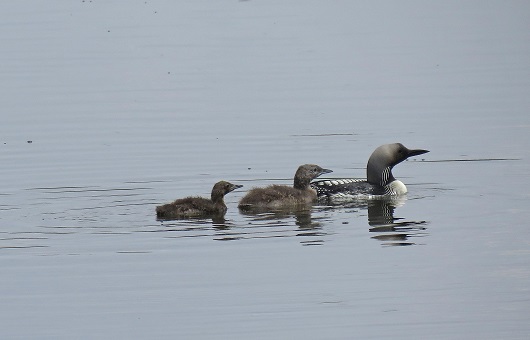
A couple of Pere David’s Snowfinch and a few of the more common White-winged Snowfinch put in appearances as we ascended back to the Twin Leopard Ger Camp which was our base for the week. Our first few Mongolian Finch were also seen.
Mammals were awesome today. The Critically Endangered Mongolian Saiga showed better than usual (normally one sees them running very fast away, but on this tour one actually stood still for a while although the heat haze prevented good photos). A den with three cute Corsac Fox with cat-like faces was another real highlight. Eastern Midday Jird, Tolai Hare, Long-tailed Ground-squirrel and Red-cheeked Ground-squirrel were other species we saw.
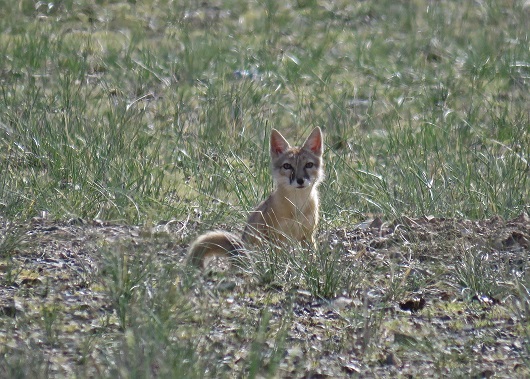
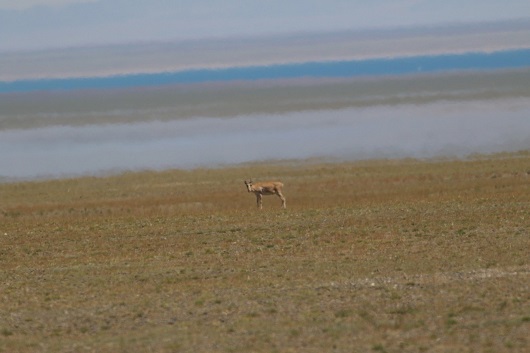
Sue found and photographed a Toed-headed Agama while we split up to search (unsuccessfully) for Oriental Plover.
Day 4, 15th July 2022. Snow Leopard – first try
Today was our first attempt to locate a Snow Leopard. We spent the bulk of the day scanning for this huge cat at around 10,000 feet (3,100 metres). We didn’t manage to find a leopard, but small mammals proved abundant at this high altitude. These included large numbers of Mongolian Marmot (a favorite Snow Leopard food in summer) along with Pallas’s Pika everywhere. A couple of Red Fox were also around.
As we scanned for Snow Leopard, we picked up great birds, along with all the small mammals. John found a Himalayan Snowcock with two young which we scoped and enjoyed watching. Cinereous and Himalayan Vulture regularly overflew our viewing area, and a Bearded Vulture put on a spectacular show flying below us and then landing on a ledge; what a bird! Golden Eagle was also seen really well, another beaut!
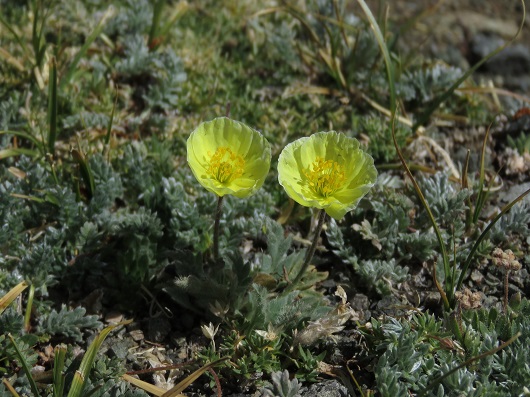
High altitude flowers were a real feature of this tour.
Black Redstart and Guldenstadt’s Redstart were both present in reasonable numbers, the former at lower elevations on the way back to camp and the latter right up in the leopard area. Similarly, Blyth’s Pipit displayed at lower elevations and Water Pipit sat atop rocks at higher altitudes. Brown Accentor were all over the place, but we had to wait until the next day to see close-up Altai Accentor.
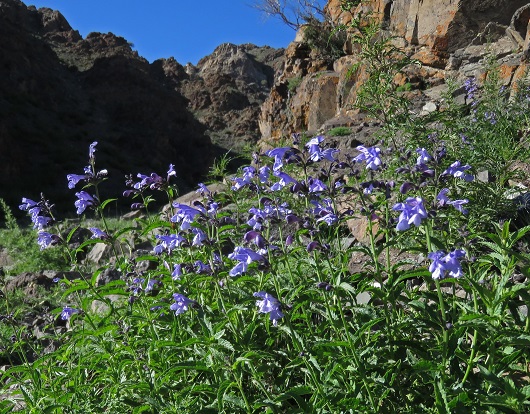
Day 5, 16th July 2022. Snow Leopard success!
We began the day with a mini kangaroo like Siberian (Mongolian Five-toed) Gerboa which the camp staff caught and then released for us so we could see it. This was a great mammal to warm up the day with!
Twite, much better views of Mongolian Finch and several Barred Warbler put in appearances as we ascended to the leopard area this morning.
At the top again, Steppe Eagle, Golden Eagle and other raptors entertained us while we scanned again for camouflaged Snow Leopard.
Although the vast Mongolian landscape, plentiful raptors and a number of other birds and mammals did keep us entertained to some degree, after hours of searching for the elusive Snow Leopard, we struggled to keep our motivation up. Our driver and trackers stopped to chat to anyone we encountered – only a handful of people during the course of the day (being in such a sparsely-populated country). Leads were seemingly weak and thin, but our guide and trackers collected as much information as possible. One piece of information actually started leading somewhere. A small team of horses had wondered down into the valley and sadly for them only two of three foals returned. So, trackers were then sent into the valley to search for the foal and believe it or not it was found, seemingly having been killed by a predator, unlikely wolves and more likely Snow Leopard. There was no leopard at the carcass, but after an hour or so of searching the general area, the trackers actually located the SNOW LEOPARD nearby as per the photo below. We did some serious 4×4 off-roading and eventually got to a place where we could get this magnificent cat into our scopes. It was lying there, but after a while it got up and slowly walked to its carcass, by no means in a hurry and indeed stopping frequently along the way, including to rest on a big rock at one point. What a typical cat. There is simply no way of describing in words the exhilaration of laying eyes on this mega-cat, one of our top handful of wildlife experiences of our lives!
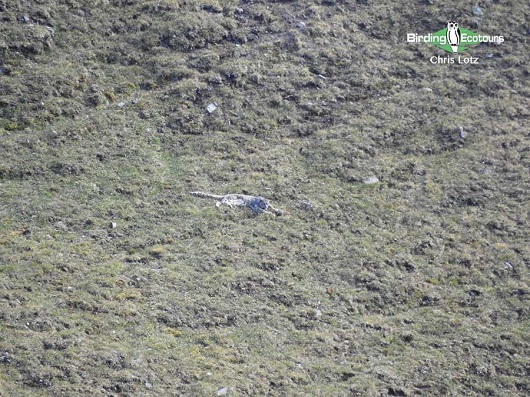
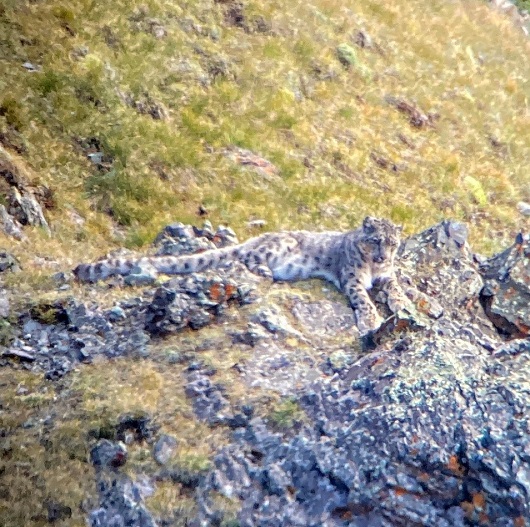
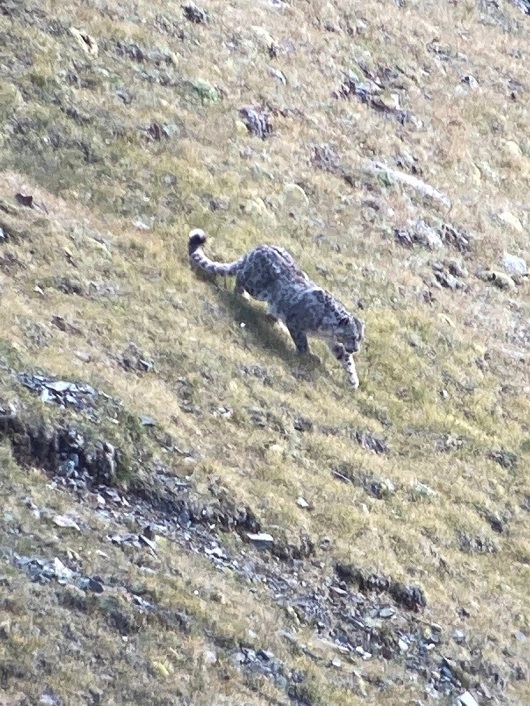
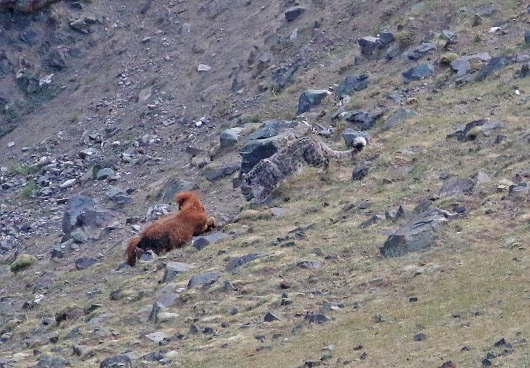
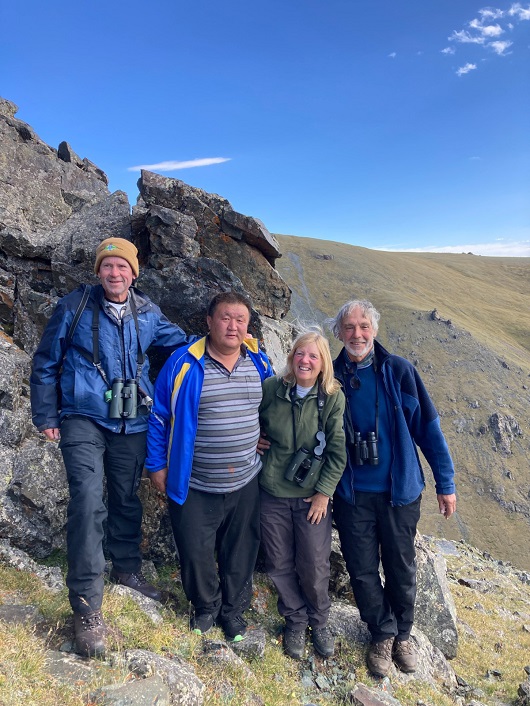
Day 6, 17th July 2022. Rest day! (Reward for Snow Leopard success)
Since we found Snow Leopard earlier than we expected (we had over a week here, as it can take days to find this camouflaged and elusive cat), we opted to take a day off, unprecedented on a birding/wildlife tour but welcome so we could catch up with photo editing, trip report writing and so forth. We spent most of the day doing this and relaxing, but in the late afternoon we walked up the valley to try and find some new trip birds.
Our late afternoon walk was productive. One of the highlights was a pair of Bearded Vulture giving spectacular views as they soared overhead and at times perched together on a ledge. Flocks of Hill Pigeon gave good views as they perched on rocks and flew overhead. Large numbers of Eurasian Crag Martin, Eurasian House Martin and Common Swift wheeled overhead and at times went to their nests/roosts on the cliff face. We also got close-up views of a Sulphur-bellied Warbler which had lost its tail so looked a bit strange. Black Redstart was plentiful and we saw our first Common Rock Thrush (including a singing male). White-winged Snowfinch, Twite, Mongolian Finch and Brown Accentor were also in evidence.
Day 7, 18th July 2022. Lake and steppe birding
Today we headed back to the Durgan (briefly) and Khar Lakes. These lakes were absolutely teaming with birds. Abundant Bearded Reedling were everywhere. There were a lot of Paddyfield Warbler and smaller numbers of Blyth’s Reed Warbler. Fair numbers of Common Reed Bunting were around. A Great Reed Warbler gave far better views than usual as it sat on a wooden bridge for a little bit. We counted around 50 Eurasian Spoonbill, vast numbers of Grey Heron, Great Egret, Black-winged Stilt and so many others. We found our first Red-necked Phalarope and saw close-up breeding plumage Black-throated Loon with young. Demoiselle Crane also put in an appearance. Ruddy Shelduck, our first Common Shelduck, a Northern Pintail, four Common Goldeneye, a small flock of Northern Shoveler and various other wildfowl species were in evidence. A few breeding plumage Black-necked Grebe, a couple of non-breeding plumage Horned (Slavonian) Grebe and stacks of Great Crested Grebe were also around. Just under 40 Pallas’s Sandgrouse were seen on the plains besides the lake. We managed to hear a Brown-cheeked Rail in the reeds at one stage. A close-up Steppe Eagle sitting on the ground provided fabulous views, as did a beautiful plumage male Desert Wheatear.
Our lunch break was really rewarding. We must have found the only three trees in the region, giving us welcome shade in the heat of the day. Some Eurasian Hoopoe, a wonderful hepatic Common Cuckoo, a couple of fresh plumage Rosy Starling and our first flock of Common Starling all showed well. We had brief views of a Long-tailed Rosefinch and heard a White-crowned Penduline Tit (but we would have to wait until another day to lay eyes on this species).
Day 8, 19th July 2022. Bumbat Mountains birding
Today we birded the beautiful, pristine Builaas Valley in the Bumbat Mountains. As we arrived in the valley, we saw and heard a covey of Chukar. Several Barred Warbler and Greenish Warbler were around. One of the highlights was finding a European Nightjar roosting under a bush, allowing close-up views. As usual for Mongolia, this was a great day for raptors, with Bearded Vulture, Saker (great views of this magnificent falcon!), Golden Eagle and our first Booted Eagle for the trip (close flight views). We also got great views of an Ermine (Stout) that caught a Pallas’s Pika.
We had a lovely lunch along a stream in this otherwise arid valley, and found a family of Grey Wagtail, many Twite, a really close-up Grey-necked Bunting drinking and bathing really close to us, and various other species.
On our way home, we saw a Pied Wheatear along with a number of other birds we’d already become well-acquainted with on previous days.
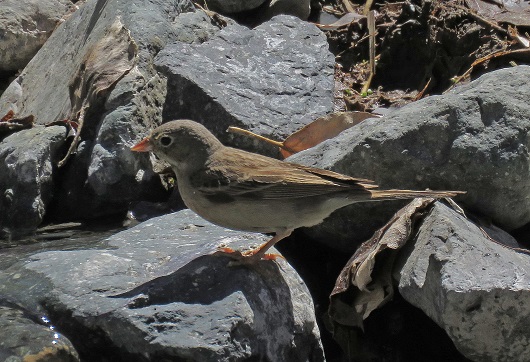
Day 9, 20th July 2022. Birding Hudoo Lake and other nearby lakes
We descended into the vast valley between mountain ranges along the main highway (the AH-4). As we left the camp, we found five Cinereous Vulture feeding on a goat that we guess may have been killed by a wolf. As we reached the valley bottom, we encountered a very obliging Asian Desert Warbler and a couple of flocks of Pallas’s Sandgrouse. Hudoo Lake and nearby lakes were full of birds including some new species such as a pair of Garganey but we were unable to find our targets (such as White-headed Duck) which we’d need to wait for later days to see.
Day 10, 21st July 2022. Riverine birding and transfer to Khar-Us Lakes
After breakfast, we headed to Manhan for some riverine birding. Here we scoped a Black Stork on its nest. We also got good views of a number of White-crowned Penduline Tit and European Greenfinch.
We then proceeded to a basic ger camp at Durgan Lake. The location was wonderful and poised us well for the next morning.
Days 11-12, 22nd – 23rd July 2022. Khar-Us Lakes
Target birds were proving difficult to find but we did finally see a couple of family groups of Swan Goose. We also heard and saw our first Pallas’s Grasshopper Warbler; there were quite a number of them showing well and being nicely vocal. We also thoroughly enjoyed seeing a few more Demoiselle Crane (including a pair with young), three Common Crane, a huge number of Pallas’s Gull, and all the other water-associated birds that we had enjoyed on previous occasions. These included really large numbers of Eurasian Spoonbill, Great Egret and Grey Heron everywhere, and big rafts of Red-crested Pochard. We also enjoyed two magnificent White-tailed Eagle that at one point had an aerial dispute with each other. We eventually caught up with White-headed Duck, an unusual an attractive-looking species. We also enjoyed lots of waders including some breeding plumage Spotted Redshank along with numerous Common Redshank, Black-tailed Godwit, Green Sandpiper, Wood Sandpiper, Common Sandpiper, breeding plumage Red-necked Phalarope, a number of Marsh Sandpiper, Greenshank, Temminck’s Stint, Little Stint, Greater Sand Plover, Kentish Plover, Little Ringed Plover and others.
Pallas’s Gull, Vega (Mongolian) Gull and Caspian Tern.
Day 13, 24th July 2022. Birding in the mountains near Hovd
After breakfast, we drove up into the mountains near Hovd to try for Kozlov’s Accentor and after a couple of hours of hard work we indeed found one that co-operated very well – hooray! We’d been hoping to see this species several times before, but just couldn’t find it – yet. We also saw two Steppe Eagle in display flight – impressive! A couple of Cinereous Vulture also soared over a few times. We managed to obtain better views of Blyth’s Pipit than previously (although this would be a common bird at the Pallas’s Cat site). Two immature Grey-necked Bunting were right next to the road at one point. A couple of coveys of Chukar put on a show.
Mammal-wise, we saw a baby Ermine (Stoat) on the prowl.
We went back to our hotel in Hovd for lunch and to freshen up before attempting to fly back to Ulaanbaatar for the final leg of our journey. Unfortunately, after we’d checked in, we were told by the airline that our flight was only going to leave the next morning, so we had to check into a tourist ger camp (although a very pleasant one with a magnificent view) near the airport for the night.
Day 14, 25th July 2022. To our Pallas’s Cat site
Fortunately, our flight did take off this morning and we landed in Ulaanbaatar and drove immediately to the Pallas’s Cat ger camp. This was essentially a travel day, but we did enjoy our first of many Mongolian Lark (a very attractive looking lark being relatively colorful especially during its interesting display flight). We also enjoyed some new trip mammals in the form of Wapiti, Mongolian Gazelle and Argali.
Day 15, 26th July 2022. Pallas’s Cat ger camp and back to the Mongolica Resort
An early morning drive proved frustrating as only the leaders saw a Pallas’s Cat running, and we didn’t manage to relocate it. We opted to return to the Mongolica Resort near Ulaanbaatar after lunch to enjoy relative comfort and to use that as a base. The Pallas’s Cat ger camp was worse for wear after the Covid pandemic had wreaked havoc, hence our decision. Currently, we are sorting this out with them and hope to be able to get the situation improved before our next Mongolian mammals tour as overnighting at the cat site definitely increases the chances of seeing it (rather than staying overnight near the capital) as one can more easily do night drives and so forth.
Day 16, 27th July 2022. Przewalski’s Horse, White-naped Crane and more!
Today was awesome! After a relaxed breakfast, we drove to the beautiful Hustai National Park, where we found our main target, Przewalski’s Horse, without much difficulty. We then had time to look for our avian targets and were not disappointed. A male Daurian Partridge showed well, as did a singing Meadow Pipit. A beautiful Daurian Redstart at a nest with a large chick, was a true delight to see. A couple of Golden Eagle were around.
Przewalski’s Horses
We then proceeded to our White-naped Crane site and were rewarded with a pair of these elegant birds. We were also delighted to find a Yellow-breasted Bunting and Pallas’s Reed Bunting among a large number of beautiful Citrine Wagtail. There were numerous waterbirds and waders, including around 100 Eurasian Spoonbill.
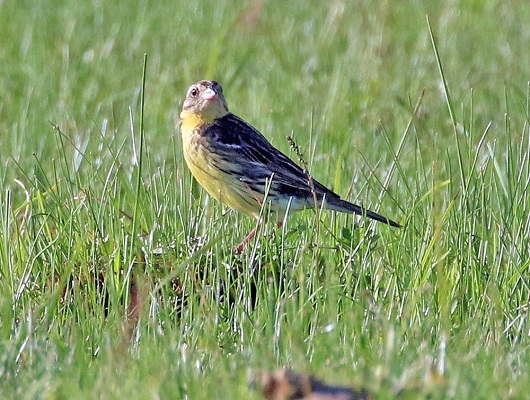
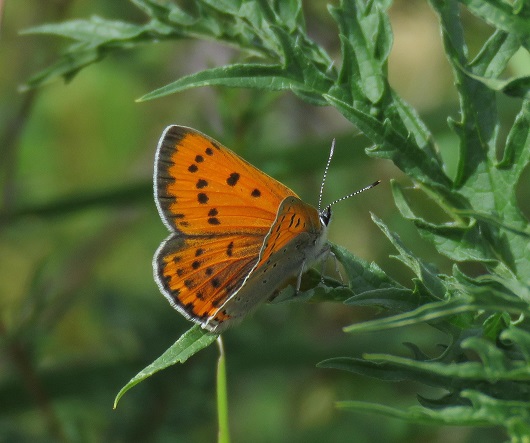
Day 17, 28th July 2022. Relaxing at the hotel (unusual on a birding/mammal tour!)
We spent the day relaxing (and catching up on photo processing and trip report writing!) while our trackers tried to locate Pallas’s Cat for us. Part of the reason for this was the rainy weather, although it cleared up nicely in the late afternoon so we walked around the hotel grounds and adjacent areas. We did not find any new trip birds or mammals today, but we did find some good plants such as the orchid pictured below.
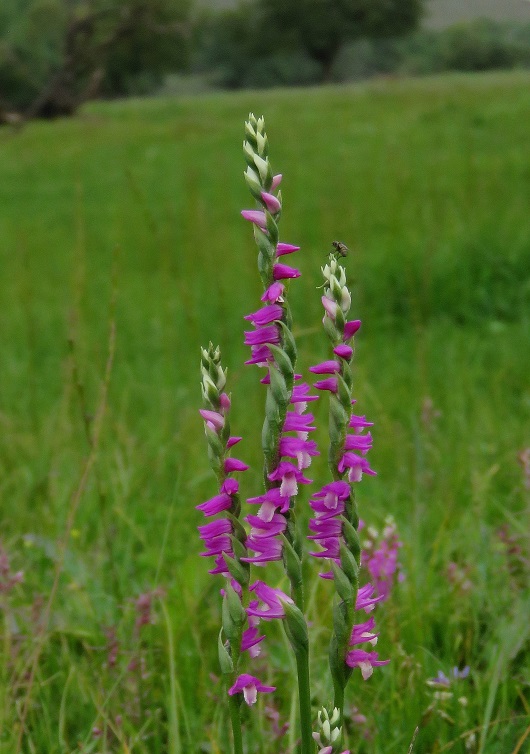
Day 18, 29th July 2022. Search for Pallas’s Cat
After a relaxing morning at the hotel, we headed back into the mountains for another attempt at Pallas’s Cat. We tried some den sites in the afternoon. We didn’t have success with the cat but found some great birds. These included a singing Kozlov’s Accentor and three Pallas’s Reed Bunting (a misnomer as they don’t inhabit reeds) including a cracking male. We also heard a Japanese Quail but were unable to get visuals on it.
In the evening, we did a long night drive and found many Corsac Fox but sadly no Pallas’s Cat. We slept the night at the ger camp.
Day 19, 30th July 2022. Making our way back to Ulaanbaatar
We pottered around the mountains hoping for Pallas’s Cat again but did not find any (or anything new). We eventually made our way back to our hotel near the airport to ready ourselves for our long flight back to the UK.
Day 20, 312t July 2022. Flights home
We headed to the airport early to catch our flights back to England.
Bird List – Following IOC (12.1)
Birds ‘heard only’ are marked with (H) after the common name, all other species were seen. Please also refer to taxonomic notes below the bird list for further information.
The following notation after species names is used to show conservation status following BirdLife International: EN = Endangered, and VU = Vulnerable.
|
Common Name |
Scientific Name |
|
|
|
|
Ducks, Geese and Swans (Anatidae) |
|
|
Bar-headed Goose |
Anser indicus |
|
Greylag Goose |
Anser anser |
|
Swan Goose – VU |
Anser cygnoides |
|
Whooper Swan |
Cygnus cygnus |
|
Common Shelduck |
Tadorna tadorna |
|
Ruddy Shelduck |
Tadorna ferruginea |
|
Gadwall |
Anas strepera |
|
Eurasian Wigeon |
Anas penelope |
|
Mallard |
Anas platyrhynchos |
|
Northern Shoveler |
Anas clypeata |
|
Northern Pintail |
Anas acuta |
|
Garganey |
Anas querquedula |
|
Eurasian Teal |
Anas crecca |
|
Red-crested Pochard |
Netta rufina |
|
Common Pochard – VU |
Aythya ferina |
|
Tufted Duck |
Aythya fuligula |
|
Common Goldeneye |
Bucephala clangula |
|
White-headed Duck – EN |
Oxyura leucocephala |
|
Pheasants and allies (Phasianidae) |
|
|
Altai Snowcock |
Tetraogallus altaicus |
|
Chukar Partridge |
Alectoris chukar |
|
Daurian Partridge |
Perdix dauurica |
|
Japanese Quail (H) |
Coturnix japonica |
|
Common Pheasant |
Phasianus colchicus |
|
Loons (Gaviidae) |
|
|
Black-throated Loon |
Gavia arctica |
|
Grebes (Podicipedidae) |
|
|
Great Crested Grebe |
Podiceps cristatus |
|
Horned Grebe – VU |
Podiceps auritus |
|
Black-necked Grebe |
Podiceps nigricollis |
|
Storks (Ciconiidae) |
|
|
Black Stork |
Ciconia nigra |
|
Ibises, Spoonbills (Threskiornithidae) |
|
|
Eurasian Spoonbill |
Platalea leucorodia |
|
Herons, Bitterns (Ardeidae) |
|
|
Grey Heron |
Ardea cinerea |
|
Great Egret |
Ardea alba |
|
Cormorants, Shags (Phalacrocoracidae) |
|
|
Great Cormorant |
Phalacrocorax carbo |
|
Kites, Hawks and Eagles (Accipitridae) |
|
|
Bearded Vulture |
Gypaetus barbatus |
|
Himalayan Vulture |
Gyps himalayensis |
|
Cinereous Vulture |
Aegypius monachus |
|
Booted Eagle |
Hieraaetus pennatus |
|
Steppe Eagle – EN |
Aquila nipalensis |
|
Golden Eagle |
Aquila chrysaetos |
|
Western Marsh Harrier |
Circus aeruginosus |
|
Eastern Marsh Harrier |
Circus spilonotus |
|
Black Kite |
Milvus migrans |
|
White-tailed Eagle |
Haliaeetus albicilla |
|
Upland Buzzard |
Buteo hemilasius |
|
Long-legged Buzzard |
Buteo rufinus |
|
Rails, Crakes and Coots (Rallidae) |
|
|
Brown-cheeked Rail (H) |
Rallus indicus |
|
Common Moorhen (H) |
Gallinula chloropus |
|
Eurasian Coot |
Fulica atra |
|
Cranes (Gruidae) |
|
|
White-naped Crane – VU |
Antigone vipio |
|
Demoiselle Crane |
Grus virgo |
|
Common Crane |
Grus grus |
|
Stilts, Avocets (Recurvirostridae) |
|
|
Black-winged Stilt |
Himantopus himantopus |
|
Pied Avocet |
Recurvirostra avosetta |
|
Plovers (Charadriidae) |
|
|
Northern Lapwing |
Vanellus vanellus |
|
Little Ringed Plover |
Charadrius dubius |
|
Kentish Plover |
Charadrius alexandrinus |
|
Greater Sand Plover |
Charadrius leschenaultii |
|
Sandpipers, Snipes (Scolopacidae) |
|
|
Common Snipe |
Gallinago gallinago |
|
Black-tailed Godwit |
Limosa limosa |
|
Whimbrel |
Numenius phaeopus |
|
Eurasian Curlew |
Numenius arquata |
|
Spotted Redshank |
Tringa erythropus |
|
Common Redshank |
Tringa totanus |
|
Marsh Sandpiper |
Tringa stagnatilis |
|
Common Greenshank |
Tringa nebularia |
|
Green Sandpiper |
Tringa ochropus |
|
Wood Sandpiper |
Tringa glareola |
|
Terek Sandpiper |
Xenus cinereus |
|
Common Sandpiper |
Actitis hypoleucos |
|
Curlew Sandpiper |
Calidris ferruginea |
|
Temminck’s Stint |
Calidris temminckii |
|
Little Stint |
Calidris minuta |
|
Red-necked Phalarope |
Phalaropus lobatus |
|
Gulls, Terns and Skimmers (Laridae) |
|
|
Black-headed Gull |
Chroicocephalus ridibundus |
|
Pallas’s Gull |
Ichthyaetus ichthyaetus |
|
Vega Gull |
Larus vegae |
|
Gull-billed Tern |
Gelochelidon nilotica |
|
Caspian Tern |
Hydroprogne caspia |
|
Little Tern |
Sternula albifrons |
|
Common Tern |
Sterna hirundo |
|
Whiskered Tern |
Chlidonias hybrida |
|
White-winged Tern |
Chlidonias leucopterus |
|
Black Tern |
Chlidonias niger |
|
Sandgrouse (Pteroclidae) |
|
|
Pallas’s Sandgrouse |
Syrrhaptes paradoxus |
|
Pigeons, Doves (Columbidae) |
|
|
Rock Dove |
Columba livia |
|
Hill Pigeon |
Columba rupestris |
|
Eurasian Collared Dove |
Streptopelia decaocto |
|
Cuckoos (Cuculidae) |
|
|
Common Cuckoo |
Cuculus canorus |
|
Owls (Strigidae) |
|
|
Little Owl |
Athene noctua |
|
Nightjars (Caprimulgidae) |
|
|
European Nightjar |
Caprimulgus europaeus |
|
Swifts (Apodidae) |
|
|
Common Swift |
Apus apus |
|
Pacific Swift |
Apus pacificus |
|
Hoopoes (Upupidae) |
|
|
Eurasian Hoopoe |
Upupa epops |
|
Woodpeckers (Picidae) |
|
|
Lesser Spotted Woodpecker |
Dryobates minor |
|
White-backed Woodpecker (Leader only) |
Dendrocopos leucotos |
|
Caracaras, Falcons (Falconidae) |
|
|
Common Kestrel |
Falco tinnunculus |
|
Amur Falcon |
Falco amurensis |
|
Eurasian Hobby |
Falco subbuteo |
|
Saker Falcon – EN |
Falco cherrug |
|
Shrikes (Laniidae) |
|
|
Isabelline Shrike |
Lanius isabellinus |
|
Crows, Jays (Corvidae) |
|
|
Azure-winged Magpie |
Cyanopica cyanus |
|
Eurasian Magpie |
Pica pica |
|
Henderson’s Ground Jay |
Podoces hendersoni |
|
Red-billed Chough |
Pyrrhocorax pyrrhocorax |
|
Western Jackdaw |
Coloeus monedula |
|
Daurian Jackdaw |
Coloeus dauuricus |
|
Rook |
Corvus frugilegus |
|
Carrion Crow |
Corvus corone |
|
Northern Raven |
Corvus corax |
|
Tits, Chickadees (Paridae) |
|
|
Azure Tit |
Cyanistes cyanus |
|
Great Tit |
Parus major |
|
Penduline Tits (Remizidae) |
|
|
White-crowned Penduline Tit |
Remiz coronatus |
|
Bearded Reedling (Panuridae) |
|
|
Bearded Reedling |
Panurus biarmicus |
|
Larks (Alaudidae) |
|
|
Eurasian Skylark |
Alauda arvensis |
|
Horned Lark |
Eremophila alpestris |
|
Mongolian Lark |
Melanocorypha mongolica |
|
Asian Short-toed Lark |
Alaudala cheleensis |
|
Swallows, Martins (Hirundinidae) |
|
|
Sand Martin |
Riparia riparia |
|
Pale Martin |
Riparia diluta |
|
Barn Swallow |
Hirundo rustica |
|
Eurasian Crag Martin |
Ptyonoprogne rupestris |
|
Common House Martin |
Delichon urbicum |
|
Leaf Warblers and allies (Phylloscopidae) |
|
|
Sulphur-bellied Warbler |
Phylloscopus griseolus |
|
Greenish Warbler |
Phylloscopus trochiloides |
|
Reed Warblers and allies (Acrocephalidae) |
|
|
Great Reed Warbler |
Acrocephalus arundinaceus |
|
Oriental Reed Warbler |
Acrocephalus orientalis |
|
Paddyfield Warbler |
Acrocephalus agricola |
|
Blyth’s Reed Warbler |
Acrocephalus dumetorum |
|
Grassbirds and allies (Locustellidae) |
|
|
Pallas’s Grasshopper Warbler |
Locustella certhiola |
|
Sylviid Babblers (Sylviidae) |
|
|
Barred Warbler |
Sylvia nisoria |
|
Asian Desert Warbler |
Sylvia nana |
|
Starlings, Rhabdornis (Sturnidae) |
|
|
White-cheeked Starling |
Spodiopsar cineraceus |
|
Rosy Starling |
Pastor roseus |
|
Common Starling |
Sturnus vulgaris |
|
Chats, Old World Flycatchers (Muscicapidae) |
|
|
Black Redstart |
Phoenicurus ochruros |
|
Daurian Redstart |
Phoenicurus auroreus |
|
Güldenstädt’s Redstart |
Phoenicurus erythrogastrus |
|
Common Rock Thrush |
Monticola saxatilis |
|
Northern Wheatear |
Oenanthe oenanthe |
|
Isabelline Wheatear |
Oenanthe isabellina |
|
Desert Wheatear |
Oenanthe deserti |
|
Pied Wheatear |
Oenanthe pleschanka |
|
Old World Sparrows, Snowfinches (Passeridae) |
|
|
House Sparrow |
Passer domesticus |
|
Eurasian Tree Sparrow |
Passer montanus |
|
Rock Sparrow |
Petronia petronia |
|
White-winged Snowfinch |
Montifringilla nivalis |
|
Pere David’s Snowfinch |
Pyrgilauda davidiana |
|
Accentors (Prunellidae) |
|
|
Altai Accentor |
Prunella himalayana |
|
Brown Accentor |
Prunella fulvescens |
|
Kozlov’s Accentor |
Prunella koslowi |
|
Wagtails, Pipits (Motacillidae) |
|
|
Western Yellow Wagtail |
Motacilla flava |
|
Citrine Wagtail |
Motacilla citreola |
|
Grey Wagtail |
Motacilla cinerea |
|
White Wagtail |
Motacilla alba |
|
Richard’s Pipit |
Anthus richardi |
|
Blyth’s Pipit |
Anthus godlewskii |
|
Water Pipit |
Anthus spinoletta |
|
Finches (Fringillidae) |
|
|
Mongolian Finch |
Bucanetes mongolicus |
|
Common Rosefinch (H, Leader saw) |
Carpodacus erythrinus |
|
Long-tailed Rosefinch |
Carpodacus sibiricus |
|
European Greenfinch |
Chloris chloris |
|
Twite |
Linaria flavirostris |
|
Buntings, New World Sparrows and allies (Emberizidae) |
|
|
Godlewski’s Bunting |
Emberiza godlewskii |
|
Meadow Bunting |
Emberiza cioides |
|
Grey-necked Bunting |
Emberiza buchanani |
|
Yellow-breasted Bunting – EN |
Emberiza aureola |
|
Pallas’s Reed Bunting |
Emberiza pallasi |
|
Common Reed Bunting |
Emberiza schoeniclus |
Mammal List
|
Common Name |
Scientific Name |
|
|
|
|
Ochotonidae (Ochotonidae) |
|
|
Pallas’s Pika |
Ochotona pallasii |
|
|
|
|
Leporidae (Leporidae) |
|
|
Tolai Hare |
Lepus tolai |
|
|
|
|
Sciuridae (Sciuridae) |
|
|
Long-tailed Ground Squirrel |
Urocitellus undulatus |
|
Red-cheeked Ground Squirrel |
Spermophilus erythrogenys |
|
Mongolian Marmot – EN |
Marmota sibirica |
|
|
|
|
Dipodidae (Dipodidae) |
|
|
Siberian Jerboa |
Orientallactaga sibirica |
|
|
|
|
Cricetidae (Cricetidae) |
|
|
Gobi Altai Mountain Vole |
Alticola barakshin |
|
Brandt’s Vole |
Lasiopodomys brandtii |
|
|
|
|
Muridae (Muridae) |
|
|
Eastern Midday Jird |
Meriones meridianus |
|
|
|
|
Felidae (Felidae) |
|
|
Snow Leopard – VU |
Panthera uncia |
|
Pallas’s Cat (Guides only) |
Otocolobus manul |
|
|
|
|
Canidae (Canidae) |
|
|
Corsac Fox |
Vulpes corsac |
|
Red Fox |
Vulpes vulpes |
|
|
|
|
Mustelidae (Mustelidae) |
|
|
Ermine |
Mustela erminea |
|
|
|
|
Equidae (Equidae) |
|
|
Przewalski’s Horse – EN |
Equus ferus |
|
|
|
|
Cervidae (Cervidae) |
|
|
Wapiti |
Cervus canadensis |
|
|
|
|
Bovidae (Bovidae) |
|
|
Mongolian Saiga – CR |
Saiga tatarica |
|
Goitered Gazelle – VU |
Gazella subgutturosa |
|
Mongolian Gazelle |
Procapra gutturosa |
|
Argali |
Ovis ammon |
This is a sample trip report. Please email us ([email protected]) for more trip reports from this destination.
